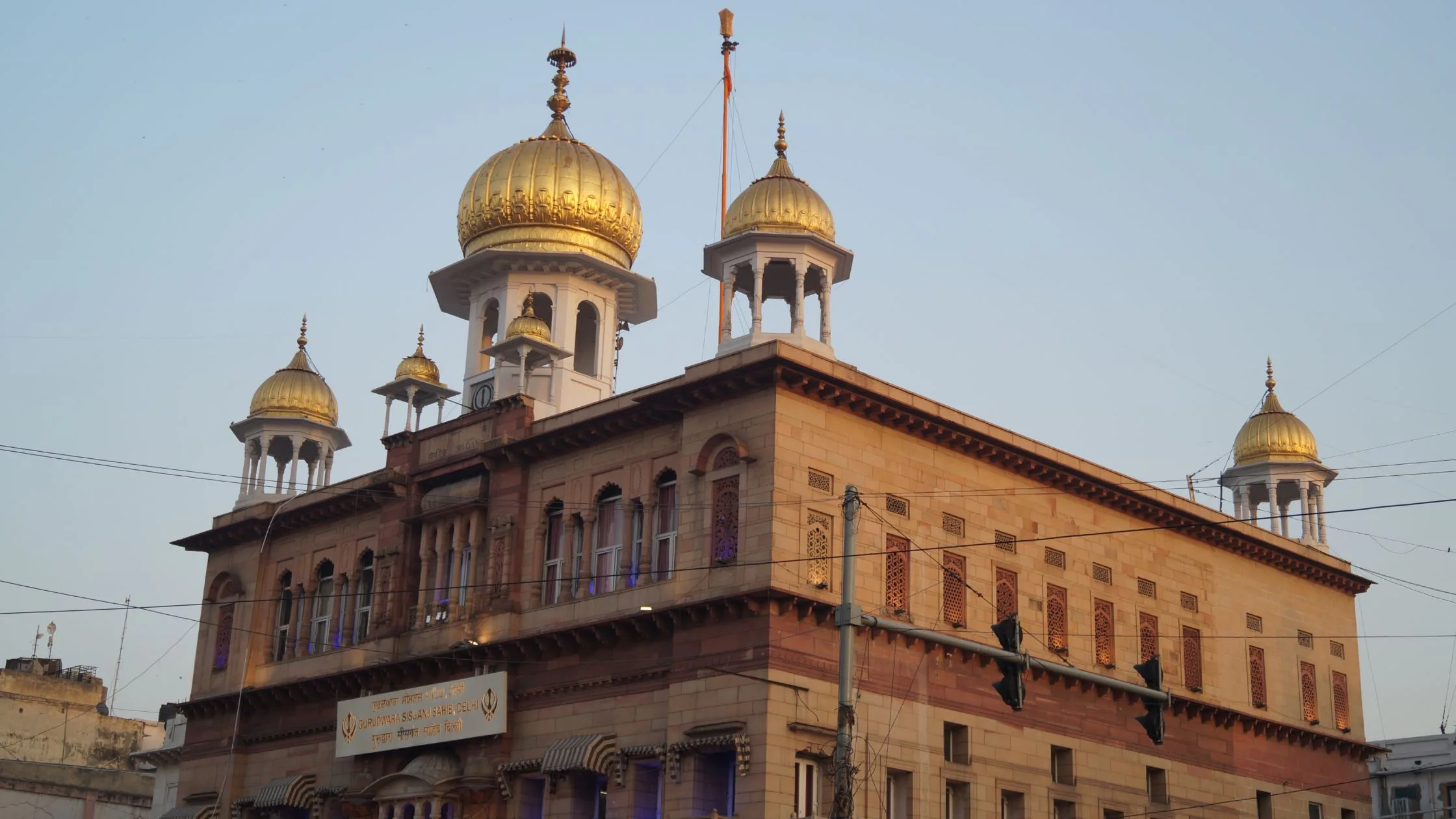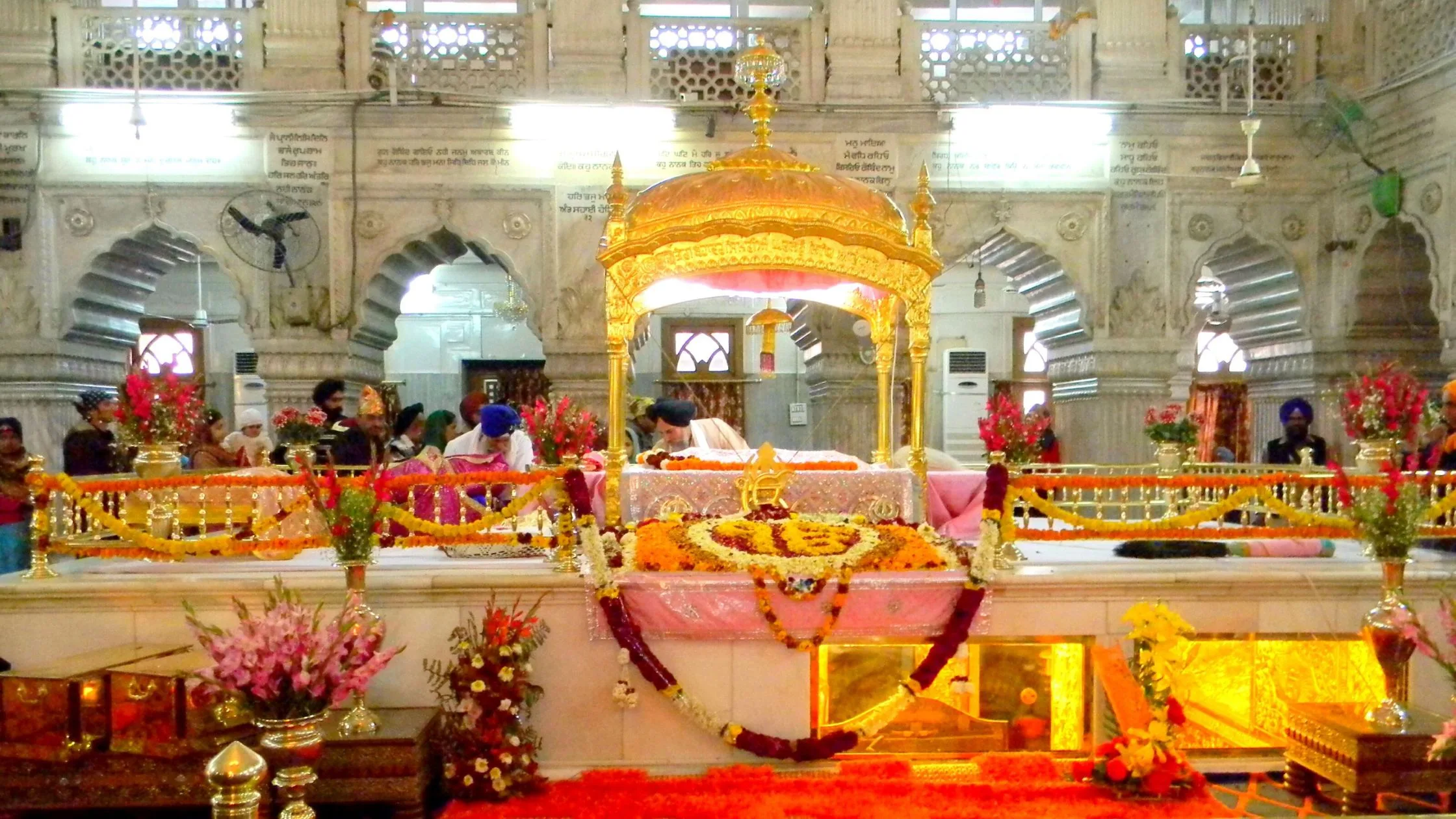Delhi has nine historical Gurdwaras, and one of them is Sis Ganj Gurudwara of Delhi. Baghel Singh first built it in 1783 as a small shrine to honor the spot where the ninth Sikh Guru, Guru Tegh Bahadur, died.
The Gurdwara was later rebuilt in 1930 and is now a prominent landmark in the city, attracting thousands of visitors every year. It is known for its beautiful architecture and peaceful atmosphere.
It was most likely later expanded following the Indian Rebellion of 1857 or after the Partition of India. Prior to its construction, the Mughal Kotwali (police station and jail) was located here.
The British destroyed the Mughal Kotwali after the Indian Rebellion of 1857. And the land was given to the Sikhs because the Sikh Maharaja of Patiala and other Sikh soldiers contributed a significant number of soldiers and ammunition to the British effort to defeat the Mughal soldiers.
Under British Rule, the majority of the roads in Lutyens’ New Delhi construction were built by contractor Rai Bahadur Narain Singh, who also built the building that is there today.
Since 1979, the Sikh Regiment of the Indian Army has saluted Sis Ganj Gurudwara before saluting the President of India, the only instance where the Indian Army salutes twice during a Republic Day parade.
History of Sis Ganj Gurudwara of Delhi
The ninth Sikh Guru, Guru Tegh Bahadur, was beheaded here on November 24, 1675, on the orders of the Mughal Emperor Aurangzeb for refusing to convert to Islam, and his martyrdom is considered a significant event in Sikh history.

However, before their body could be quartered and exposed to public view, it was stolen under darkness by one of his disciples, Lakhi Shah Vanjara, who then burned his house to cremate Guru’s body. Now, this place is recognized as Gurdwara Rakab Ganj Sahib.
The trunk of the tree beneath which the head of the Guru was severed and the well-used by him for taking baths during his prison term have been preserved in the shrine. Also adjoining the gurdwara is the Kotwali (police station), where Guru was imprisoned, and his disciples were tortured. It is located close to the Sunehri Masjid (Chandni Chowk).
The severed head (“Sis”) of Guru Tegh Bahadur was brought to Anandpur Sahib by Bhai Jaita. He belonged to the Majhabi (scavenger) caste. He changed his name to Bhai Jivan Singh on the day Guru Gobind Rai founded Khalsa in 1699 and added the name Singh or Kaur to the names of all original Sikhs.
There is another gurudwara by the same name, Gurudwara Sis Ganj Sahib at Anandpur Sahib in Punjab, where, in November 1675, the head of the martyred Guru Teg Bahadur, brought by Bhai Jaita (renamed Bhai Jivan Singh according to Sikh rites), was cremated.
The last Sikh guru, Guru Gobind Singh, continued his mission to bring peace and freedom to the country. However, the mission was not completed until thousands of captive Sikhs were killed in Delhi, including Bandar Singh Bahadur, who served as his guru, and Guru Gobind Singh Ji, who gave his all.

The Acquisition and Construction of the Gurudwara
On March 11, 1783, Sikh military leader Baghel Singh (1730–1802) marched into Delhi; he also brought with him his army. He occupied the Diwan-i-Am, and the Mughal emperor Shah Alam II made a settlement with them, agreeing to allow Baghel Singh to raise gurudwaras on Sikh historical sites in the city and receive six annas in a rupee (37.5%) of all the taxes in the capital.
Sis Ganj was one of the shrines he built within the span of eight months, from April to November 1783. However, due to the sensitive political climate of the coming century, the place alternated between being a mosque and a gurdwara. It became a site of a dispute between two communities, and lawsuits followed.
Eventually, after prolonged litigation, the Privy Council during the British Raj ruled in favor of the Sikh litigants. The present structure was added in 1930; the gold guild of the domes was added in the coming years. The Mughal-era Kotwali was later given to the Delhi Sikh Gurdwara Management Committee around 1971.
The Glory of Sikkhism Connected with the Gurudwara
The ancient city is drenched in the holy blood of thousands of Sikh jewels. These include the courageous and intrepid martyrs who have defended and served the noblest causes of humanity. They believed in fighting or dying to protect your freedom, the right to practice one’s religion, and the freedom guaranteed by justice.

Beginning with Guru Arjan Dev and going all the way to Guru Tegh Bahadur, Sikh Gurus paved the way for Sikhs, and as history attests, Sikhs did not shy away from their responsibilities. Thousands of Sikhs did not hesitate to take this difficult and treacherous path, as evidenced by the many monuments and monuments that still exist in this great city commemorating the Sikhs who died in battle in the 18th century.
Many Sikhs showed ruthless determination to root out the tyranny of injustice from the sanctuary of saints. This included Guru Tegh Bahadur, Banda Singh Bahadur, Jassa Singh Ahluwalia, Bhai Baghel Singh, and Bhagat Singh. Their blood and sweat soaked this historic city floor. Without these steadfast souls of the Lord, the city would not have had independence, democracy, and freedom.
The twin cities of Old Delhi and New Delhi are not only the capitals of India. They have also become the center and hub of all political activities. Since independence, it has grown in importance as the seat of the largest democracy in the world.
The Beliefs of the Disciples
There are nine historical Gurdwaras that are connected to important events that took place in this city. The events that had a major impact on the history of Punjab and India changed its course and direction.
These Gurdwaras are not only significant religious sites for the Sikh community. They also serve as a reminder of the sacrifices made by their ancestors in the struggle for freedom and justice. Visiting these sites is a way to pay homage to those who fought for their beliefs and values.

A Gurdwara (Sis Ganj) of the same name also stands at the cremation site of Guru Tegh Bahadur ji’s holy head. Across the narrow road from Gurudwara stands a small shrine. It marks the area where three of the Gurudwara’s closest disciples were individually burned to death as part of a grave atrocity committed by the emperor against hundreds of disciples, boiled in a pot and cut in half. Witnessing these heinous acts of the site being portrayed as an artist’s reconstruction still sends shivers down the spines of onlookers.
Anyone who visits these shrines is taken aback by the amount of torture Sikhs went through in order to save their religion and to save humanity, people visit these places to pay respect to the sacrifices made by our ancestors and also to seek blessings.
Marvel at the architecture
- Sis Ganj Gurudwara is built in the Mughal architectural style with lattice windows, pavilions, and balustrades, all made of sandstone instead of the usual white marble like other Gurudwaras.
- Notably, due to the sensitive political climate, it was used alternately as a mosque and a gurdwara for a long time before finally being converted into a full-fledged gurudwara with golden domes in 1930.
- It has a separate building that serves as a Langar (free kitchen) as well as accommodation for tourists and homeless people.
- It also houses relics from the guru’s life. For e.g., the well from which he drank in captivity and the tree trunk on which he was executed. Devotees come from far and wide to pay homage to the brave Sikh Guru.
- The main prayer hall is a beautiful two-story structure. It has high ceilings, large glass chandeliers, and the Guru Granth Sahib, the holy book of the Sikhs.
- Sacred scriptures are recited and explained, and Bhajan Kirtans (devotional songs) are sung in praise of the Lord throughout the day.

- One of the things that distinguish Gurudwaras from other places of worship is the extraordinary camaraderie among its inhabitants.
- Usually, you will find a helpful and friendly Sikh who will show you around the place and give you all the necessary knowledge about its importance and its code of conduct. The staff and regulars at Gurudwara are always friendly. There is always an interesting fact or two to share with you about their religion and its history. A rewarding experience every time.
- Gurudwara is just a minute’s walk from MRT Chandni Chowk Station and close to other popular tourist attractions such as the Red Fort and Jama Masjid.
Conclusion
All in all, Gurdwara Sis Ganj Sahib is believed to be one of the most peaceful gurudwaras in the city due to the rich and eye-watering history of this place. Visiting this gurudwara can be a truly enriching experience for anyone who wants to learn more about Sikhism and its culture. It is definitely worth a visit for those seeking spiritual solace and tranquility. The place has an aura like no other, and the tourists visiting the city make it a point to visit the gurdwara due to its significance and all that it has to offer like its marvelous architecture. Since it’s located in Chandni Chowk, it’s convenient for tourists to visit the gurdwara from Chandni Chowk too.

